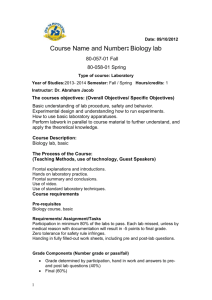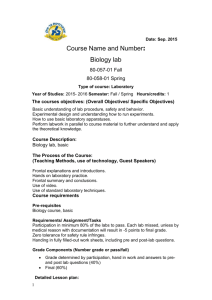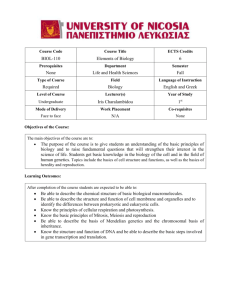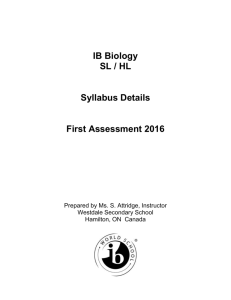AP Biology Prep Course Syllabus
advertisement
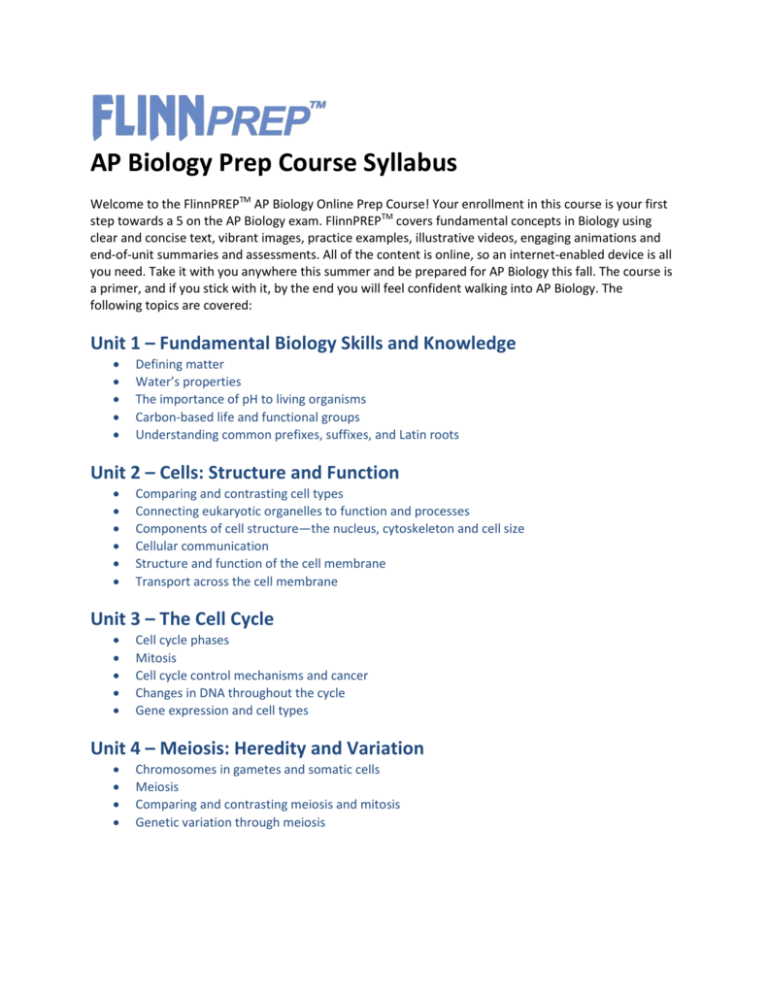
AP Biology Prep Course Syllabus Welcome to the FlinnPREPTM AP Biology Online Prep Course! Your enrollment in this course is your first step towards a 5 on the AP Biology exam. FlinnPREPTM covers fundamental concepts in Biology using clear and concise text, vibrant images, practice examples, illustrative videos, engaging animations and end-of-unit summaries and assessments. All of the content is online, so an internet-enabled device is all you need. Take it with you anywhere this summer and be prepared for AP Biology this fall. The course is a primer, and if you stick with it, by the end you will feel confident walking into AP Biology. The following topics are covered: Unit 1 – Fundamental Biology Skills and Knowledge • • • • • Defining matter Water’s properties The importance of pH to living organisms Carbon-based life and functional groups Understanding common prefixes, suffixes, and Latin roots Unit 2 – Cells: Structure and Function • • • • • • Comparing and contrasting cell types Connecting eukaryotic organelles to function and processes Components of cell structure—the nucleus, cytoskeleton and cell size Cellular communication Structure and function of the cell membrane Transport across the cell membrane Unit 3 – The Cell Cycle • • • • • Cell cycle phases Mitosis Cell cycle control mechanisms and cancer Changes in DNA throughout the cycle Gene expression and cell types Unit 4 – Meiosis: Heredity and Variation • • • • Chromosomes in gametes and somatic cells Meiosis Comparing and contrasting meiosis and mitosis Genetic variation through meiosis AP Biology Prep Course Syllabus, Continued Unit 5 – Mendelian and Molecular Genetics • • • • • • Mendelian laws of inheritance Monohybrid and dihybrid crosses DNA structure DNA replication DNA mutations and repairs From gene to protein: transcription and translation Unit 6 – Evidence of Evolution • • • • • • • • Darwin’s theory of evolution through natural selection Geologic and evolutionary timeline Using radiometric and relative dating to determine the fossil record Anatomical structures and molecular evidence Whale evolution case study Evidence of common ancestry and universal homologies Constructing phylogenetic trees to determine evolutionary relationships Direct evidence of evolution Unit 7 – Evolution: Natural Selection • • • • • • Conditions for natural selection Genetic variation Overproduction of offspring Struggle for existence and differential survival and reproduction Sexual selection Artificial selection Unit 8 – Evolution: Populations • • • • • • • • Microevolution in populations Hardy-Weinberg equilibrium conditions and calculations Determining if changes are adaptive or chance Genetic drift and gene flow Contributions to variation due to mutations Evolution of multi-gene traits Speciation: a case of reproductive isolation Ecological definition of a species; hybridization case study AP Biology Prep Course Syllabus, Continued Unit 9 – Interdependence in Ecosystems • • • • • • • • • Abiotic and biotic factors in ecosystems The influence of climate on dominate communities Symbiotic relationships Predator-prey dynamics Impact of competition on individuals and populations Facilitation and succession Stability and disturbance Population dynamics Ecosystem health Unit 10 – Ecology: Energy Flow and Nutrient Cycling • • • • • • • Elemental components of living things Nitrogen cycle—nature’s predicament with an abundant element Carbon cycle Photosynthesis and respiration Energy transformation Energy transfer between trophic levels Bioaccumulation and biomagnification of toxins For more information on this course, please contact the FlinnPREP™ team: flinnprep@flinnsci.com 800-452-1261 (M – F; 7:30 am – 5:00 pm CT)


